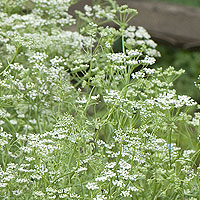Anise
 © Martin Wall
© Martin WallParts Used & Where Grown
The seeds of this aromatic plant are used as both medicine and as a cooking spice. Anise comes from Eurasia but is now grown in gardens all over the world.
- Reliable and relatively consistent scientific data showing a substantial health benefit.
- Contradictory, insufficient, or preliminary studies suggesting a health benefit or minimal health benefit.
- For an herb, supported by traditional use but minimal or no scientific evidence. For a supplement, little scientific support.
Our proprietary “Star-Rating” system was developed to help you easily understand the amount of scientific support behind each supplement in relation to a specific health condition. While there is no way to predict whether a vitamin, mineral, or herb will successfully treat or prevent associated health conditions, our unique ratings tell you how well these supplements are understood by the medical community, and whether studies have found them to be effective for other people.
For over a decade, our team has combed through thousands of research articles published in reputable journals. To help you make educated decisions, and to better understand controversial or confusing supplements, our medical experts have digested the science into these three easy-to-follow ratings. We hope this provides you with a helpful resource to make informed decisions towards your health and well-being.
This supplement has been used in connection with the following health conditions:
| Used for | Amount | Why |
|---|---|---|
Breast-Feeding Support | Refer to label instructions | Anise has traditionally been used in some cultures to support breast-feeding, although no research has confirmed its effectiveness. |
Bronchitis | Refer to label instructions | Expectorant herbs like anise help loosen bronchial secretions and make mucus easier to eliminate. |
Chronic Obstructive Pulmonary Disease | Refer to label instructions | Anise is used traditionally to promote mucus discharge. |
Cough | Refer to label instructions | The active constituents in anise, particularly the terpenoid anethole, give this plant a delightful flavor. As an antispasmodic, it helps in gently relieving spasmodic coughs. |
Head Lice (Ylang Ylang) | Refer to label instructions | A combination of anise, ylang ylang, and coconut oils has been shown to be effective against head lice. |
Indigestion, Heartburn, and Low Stomach Acidity | Refer to label instructions | Anise is a gas-relieving herb that may be helpful in calming an upset stomach. |
Parasites | Refer to label instructions | Anise may have modest antiparasitic actions and has been recommended by some practitioners as a treatment for mild intestinal parasite infections. |
Traditional Use (May Not Be Supported by Scientific Studies)
Anise has been an important flavoring in European cooking since time immemorial. Its oil has also been used as an anthelmintic—a drug used to remove intestinal parasites—though it is not considered the strongest plant in this regard.1 Anise has also been used for centuries in European herbalism to treat coughs and indigestion.2
Copyright © 2025 TraceGains, Inc. All rights reserved.
Learn more about TraceGains, the company.
The information presented by TraceGains is for informational purposes only. It is based on scientific studies (human, animal, or in vitro), clinical experience, or traditional usage as cited in each article. The results reported may not necessarily occur in all individuals. Self-treatment is not recommended for life-threatening conditions that require medical treatment under a doctor's care. For many of the conditions discussed, treatment with prescription or over the counter medication is also available. Consult your doctor, practitioner, and/or pharmacist for any health problem and before using any supplements or before making any changes in prescribed medications. Information expires December 2025.
